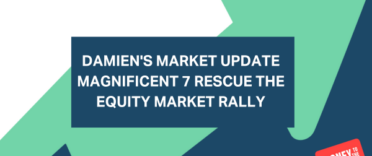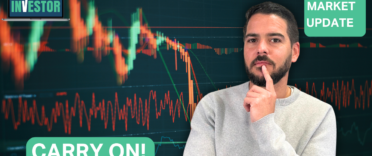Welcome to the latest episode of my monthly YouTube show where I discuss what is happening in investment markets and what to look out for. This episode I talk about how bond and equity markets have been on a journey of rejuvenation.
Each show lasts between 5-10 minutes and is aimed at DIY investors (including novices) seeking contemporary analysis to help them understand how investment markets work.
Subscribe to my YouTube channel to receive my weekly analysis of investment markets or alternatively, you can listen via my weekly Midweek Markets podcast below.
Damien's Market Update monthly podcast
Other ways to watch, listen and subscribe
You can listen to other episodes and subscribe to the show by searching 'Money to the Masses' on Spotify or by using the following links:
Abridged transcript - Damien's Market Update - January 2024
In November, we witnessed a market rejuvenation. After a disappointing October, the markets found their footing, sparked by falling bond yields and a weakening US dollar. This shift propelled the S&P 500 above key technical levels into a seasonally bullish period. The initial surge in both bond and equity markets was followed by a period of consolidation, as central banks reaffirmed their commitment to fighting inflation, which slightly dampened investors' optimism over the likelihood that interest rate cuts would come sooner rather than later.
However, lower-than-expected inflation data in the US led to a further drop in treasury yields and the US dollar index, propelling the S&P 500 towards its 2023 high. The FTSE 250, buoyed by the prospect of rate cuts, enjoyed its best month in three years, highlighting the market's overriding focus on macroeconomic indicators. The strong performance of US tech stocks and the property sector, particularly in the UK, underscored the market's sensitivity to interest rate expectations, painting a picture of a market tuned into the broader economic narrative.
Moving into December, which traditionally heralds the Santa Rally, 2023 was something of an outlier, depending on how you look at it. Based on the strict definition of the Santa Rally, when an equity market rallies across the last five trading sessions of the year and the first two of the new year, it didn't materialize in the UK or the US. However, when considering the entire month, December showcased an extraordinary rally, driven by rate cut expectations as shown by the tables on screen.
| Index | December performance % |
| Nasdaq 100 | 5.51 |
| Dow Jones Composite Average | 4.76 |
| S&P 500 | 4.42 |
| MSCI ACWI | 3.95 |
| FTSE 100 | 3.75 |
| FTSE Eurofirst 300 | 3.51 |
| Deutsche Borse DAX 30 Performance | 3.31 |
| MSCI Emerging Markets | 2.95 |
| MSCI AC Asia ex Japan | 2.76 |
| Nikkei 225 | -0.07 |
This topped off a stunning year for most equity markets, especially technology stocks.
| Index | 2023 performance % |
| Nasdaq 100 | 53.81 |
| Nikkei 225 | 27.3 |
| S&P 500 | 24.23 |
| MSCI ACWI | 19.51 |
| FTSE Eurofirst 300 | 12.53 |
| Dow Jones Composite Average | 11.74 |
| Deutsche Borse DAX 30 Performance | 10.57 |
| MSCI Emerging Markets | 7.07 |
| MSCI AC Asia ex Japan | 4.05 |
| FTSE 100 | 3.78 |
Bond markets also finished the year strongly too with the average UK Corporate bond fund up over 9% for the year, with all of that profit made following November’s turnaround. But December’s performance numbers hide the reality check that investors received when entering the new year, as hawkish US central bank minutes and strong economic data challenged their rate cut expectations. As a result the 10-year US treasury yield rose back above 4%, and global bond markets had their worst start to a new year since 2010, based on the Bloomberg Global Aggregate index. This juxtaposition of a strong December rally against the backdrop of a turbulent start to January (a new year hangover?) set the stage for a market grappling with mixed signals and heightened investor caution.
With the obsession over whether there would be a Santa Rally, or not, no longer in investors’ minds, their attention turned to another seasonal investment phenomenon. At this time of year you will often hear the old investment adage “as goes January so goes the year”. Different interpretations of the adage exist. One interpretation suggests that the initial five days of January are statistically indicative of that year's overall trend, while another version, referred to as the January Barometer, states that if the stock market performs positively for the whole of January, it is likely to indicate positive returns for the stock market for the remainder of the year.
If we just focus on the 'first five days' interpretation for now, then history suggests that the last 48 ‘up first five days' were followed by full-year gains on the S&P 500 on 83% of occasions, with an average annual gain of 14%. The January effect struck gold again in 2023 with the S&P 500 up 1.37% in the first five days of the year and it eventually closed the year up 24.23%.
However, in 2024 the S&P 500 index didn’t finish the first five trading days of the year in positive territory by just 0.2%. But it must be pointed out that historical evidence doesn’t automatically suggest that a miss condemns the index to a poor year, but it raised a few eyebrows nonetheless.However, since the new year slump equity markets have shown further signs of resilience. The Nikkei broke above the 33573 resistance line, which was a 33 year high ,and the index went into orbit and is now up 6% year to date. Most other equity markets are firmly in negative territory. If the move is viewed through the prism of investment and news headlines it seems mind-boggling, but viewed through the lens of technical analysis it is at least understandable.
While breaking multi-decade highs is impressive, breaking all-time highs is more so. In fact the S&P 500 it currently within a whisker of testing its all-time closing high of 4,796.56, set on 3rd January 2022. It currently sits at 4,780 as I make this video.Of course that makes 4796 a strong line of resistance and a potential banana skin. But if the S&P 500 can close above and set a new all-time high that is a far better omen than any January Barometer or adage.
Back in 2019, for 80-20 Investor members, I published a detailed look at whether a new all-time high makes a stock market crash more likely. In reality you are 55 times more likely to see another all-time high after a new all-time high before you see a 10% correction. That of course doesn’t mean there can’t be a correction, but the odds favour the market pushing higher if we do see a new all-time high on the S&P 500.So at a time when so many competing news headlines and investment themes are causing markets to fluctuate, sometimes it helps to just focus on the objective, rather than the subjective.
So in summary, from mid-November to mid-January, bond and equity markets have been on a journey of rejuvenation, cautious optimism and resilient rebounds as investors bet on central banks cutting interest rates and inflation abating. But after such a rebound it does feel like we are at another fork in the road where key equity markets could kick on to new highs or pullback. Which way will depend on a catalyst, with the latest economic data release and central bank decisions always likely candidates.



